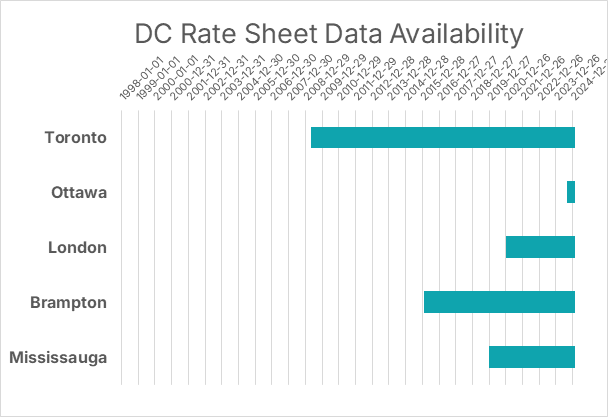Feeding the Data Monster: Why Builders Are Beating Cities at Transparency
An update in our development charge data series
Feeding the data monster
At the Missing Middle Initiative, we’ve been working to create a publicly accessible development charge (DC) database. We need this data for our work, as Meredith aptly puts it, because “Mike Moffatt… is a data monster.”
In fact, all of us at MMI are data monsters, and we know that there are many of us out there in government, academia, consultancy, journalism, planning and the general population. We know this because many people have formally and informally reached out to us to request data or our help in interpreting it.
The pursuit of the DC data has been an uphill battle, which we have documented here and here. And, while we haven’t given up on municipalities completely, we’ve decided to take an additional approach by reaching out to homebuilder associations (HBAs) to see if they can help. And did they ever!
So far, we’ve received 1,244 files transferred to us by six different organizations, which provided us with information for several dozen municipalities, stretching back decades, far more than we received directly from municipalities themselves. We want to give a shout-out of appreciation to:
Building Industry and Land Development Association (BILD);
Guelph District Homebuilders Association (GDHBA);
Peterborough and the Kawarthas Homebuilders Association (PKHBA);
West End Homebuilders Association (WEHBA); and
We’re continuing to reach out to everyone we know who may be sitting on a treasure trove of historical data. However, if we’ve missed you and you’d like to contribute, please, for the love of the province and county, don’t hesitate to get in touch. We are currently working on integrating the documents we have received from these six groups into our publicly available database, and keep an eye out here for future updates.
Mind the data gap
To put into context how little historical development charge governments make available, we examined the availability of rate sheet data on the main DC website landing pages for Toronto, Ottawa, London, Brampton, and Mississauga, going back to 1998, the first full year the modern Development Charges Act1 was in effect.
Of the five municipalities, Toronto’s data stretches back the farthest to May 2009, and no city has data available prior to 2008. The lack of pre-2008 data and the differences in data availability between municipalities make comparative research extremely difficult. Additionally, the inconsistent data availability makes conducting multi-jurisdictional analysis nearly impossible.
We shouldn’t have to rely on the private sector to do the job of government
We hope the absurdity of asking for-profit organizations to provide information about government initiatives, free of charge, is apparent. These development charge-related documents contain data generated by governments, which are extremely valuable to everyone seeking to understand the housing crisis, including policymakers and the general public. Yet it is the private sector, not governments, that is making these documents available.
The fact that we’re finding more success by reaching out to the private sector than we are to municipal governments to help build what is ultimately going to be a public good is, in a word, disappointing.
The Development Charges Act received Royal Assent on December 8th, 1997




